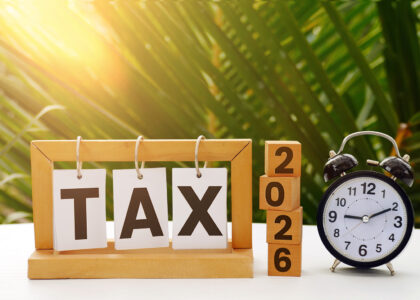The Internal Revenue Service is urging taxpayers to take proactive steps to make filing their 2023 federal income tax return easier next year.
The IRS recommends visiting the ‘Get Ready‘ page on IRS.gov as part of a series of reminders to help taxpayers prepare for the upcoming filing season. It outlines concrete steps that taxpayers can take right now to simplify the filing process in 2024.
Discover what’s new and crucial considerations to keep in mind before filing tax in 2024.
Enhancements to the IRS Online Account
Now taxpayers and Individual Taxpayer Identification Number (ITIN) holders can conveniently access their accounts. This upgraded functionality enables users to effortlessly view, approve, and electronically sign power of attorney and tax information authorizations provided by their tax professionals.
In addition to these features, an Online Account allows individuals to:
- Access a detailed overview of their tax owed and payment history, as well as schedule payments.
- Request tax transcripts.
- View or apply for payment plans.
- Access digital copies of certain IRS notices.
- Review essential data from their most recently filed tax return, including adjusted gross income.
- Validate bank accounts and securely save multiple accounts, eliminating the hassle of re-entering bank information for each payment.
Understand refund timing to avoid delays
It’s critical to consider various factors that can impact the timeline after the IRS receives your tax return. While the majority of refunds are issued in less than 21 days, the IRS advises against relying on a specific date for receiving your 2023 federal tax refund, particularly when making significant purchases or settling bills. Some returns may undergo additional review, resulting in a longer processing time if the IRS systems detect potential errors, missing information, or if there are suspicions of identity theft or fraud.
It is important to note that the IRS cannot issue refunds for individuals claiming the Earned Income Tax Credit (EITC) or Additional Child Tax Credit (ACTC) before mid-February. According to legal requirements, the IRS must withhold the entire refund, not just the portion associated with the EITC or ACTC. For those opting for direct deposit without any other complications in their tax return, the IRS anticipates that most EITC and ACTC-related refunds will be accessible in taxpayer bank accounts or on debit cards by February 27, 2024.
Submit the last quarterly payment for 2023 by January 16, 2024.
Taxpayers should consider making estimated or additional tax payments if they receive nonwage income from sources such as unemployment, self-employment, annuity income, or digital assets. Wage earners can use the IRS.gov Tax Withholding Estimator to determine whether an additional tax payment is required and to avoid unexpected tax obligations during filing.
Collect tax documents for the year 2023
It is recommended that taxpayers establish a record-keeping system, whether electronic or paper-based, to centralize critical information. Forms W-2 from employers, Forms 1099 from banks or other payers, Forms 1099-K from third-party payment networks, Forms 1099-NEC for nonemployee compensation, Forms 1099-MISC for miscellaneous income, or Forms 1099-INT for interest paid are examples of year-end income documents. It also includes keeping records of all transactions involving digital assets.
With all of the documentation in order, taxpayers are in the best position to file an accurate return, reducing the risk of processing or refund delays.
The reporting threshold for 1099-K has been postponed
The IRS has decided to postpone the implementation of the new $600 Form 1099-K reporting threshold for third-party settlement organizations for calendar year 2023 in response to feedback from taxpayers, tax professionals, and payment processors.
To avoid confusion, the IRS will treat 2023 as an additional transition year, requiring no reporting unless a taxpayer receives more than $20,000 and has more than 200 transactions during that time period.
Given the complexities of the new provision and the significant impact on individual taxpayers, the IRS intends to implement a $5,000 reporting threshold in tax year 2024 as part of a phased approach to implementing the $600 reporting threshold established under the American Rescue Plan (ARP).
Taxpayers should know the reasons behind receiving a Form 1099-K, utilizing both the form and their additional records to accurately calculate and report their income on their tax return. Additionally, it’s crucial for taxpayers to be aware of the necessary steps if they’ve received a Form 1099-K erroneously.
While the taxability of income remains unchanged, with all income, including that from part-time work, side jobs, or the sale of goods, taxable, taxpayers must report all income on their tax return unless excluded by law, regardless of whether they receive a Form 1099-K, Form 1099-NEC, Form 1099-MISC, or any other information return.
Explore energy related credits
Taxpayers who purchased a vehicle in 2023 should look into the changes made by the Inflation Reduction Act of 2022 to determine if they are eligible for credits on new electric vehicles purchased in 2022 or earlier, or on new clean vehicles purchased in 2023 or later. To claim either credit, taxpayers must provide the VIN of the vehicle and file Form 8936, Qualified Plug-in Electric Drive Motor Vehicle Credit, along with their tax return.
For those who made energy enhancements to their homes, tax credits are accessible for a portion of qualifying expenses. The Inflation Reduction Act of 2022 has widened the credit amounts and types of qualifying expenses. To avail the credit, taxpayers should file Form 5695, Residential Energy Credits, Part II, along with their tax return.
Direct deposits speed tax refunds
Electing electronic filing and direct deposit is the quickest way for taxpayers to receive their tax refund. When compared to receiving a paper check, direct deposit allows individuals to access their refunds more quickly.
Those without a bank account can get help opening one through an FDIC-insured bank or the national Credit Union Locator tool. Veterans can take advantage of the Veterans Benefits Banking Program, which provides access to financial services at participating banks.
Prepaid debit cards or mobile apps may make direct deposit of tax refunds easier. Prepaid debit cards or mobile apps with routing and account numbers are required to enter these details on the tax return. It is best to check with the mobile app provider or financial institution to confirm the correct phone numbers to use.
Begin on a seamless tax-filing journey in 2024 with ABSE Tax by your side! Our team of experts is dedicated to providing professional guidance that goes beyond just filing taxes. We’re always prepared to navigate this tax season, offering you the best suggestions and innovative ideas to safeguard those extra dollars of your hard-earned money. Connect with us now for a tax experience that’s not just easy but also rewarding!








